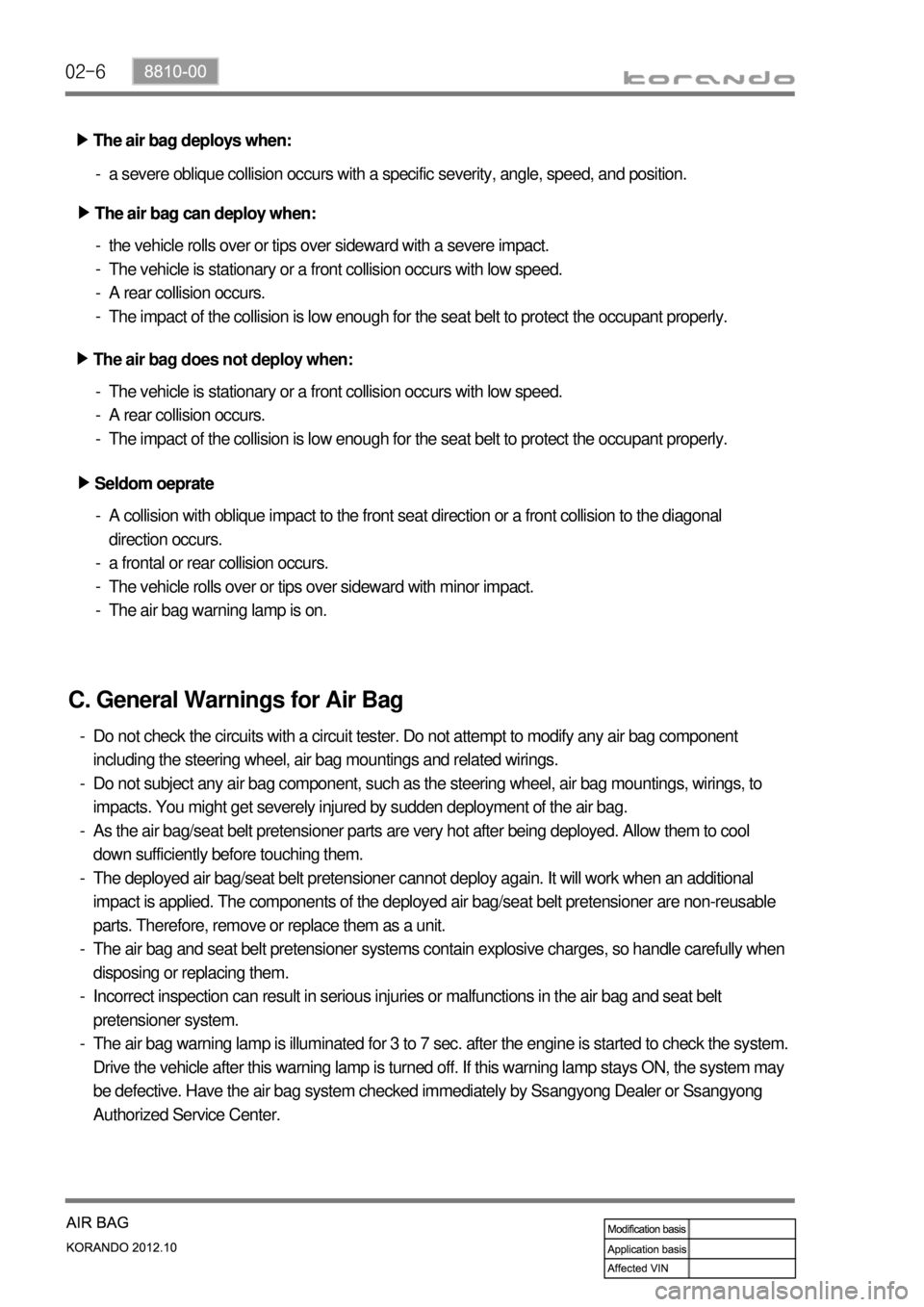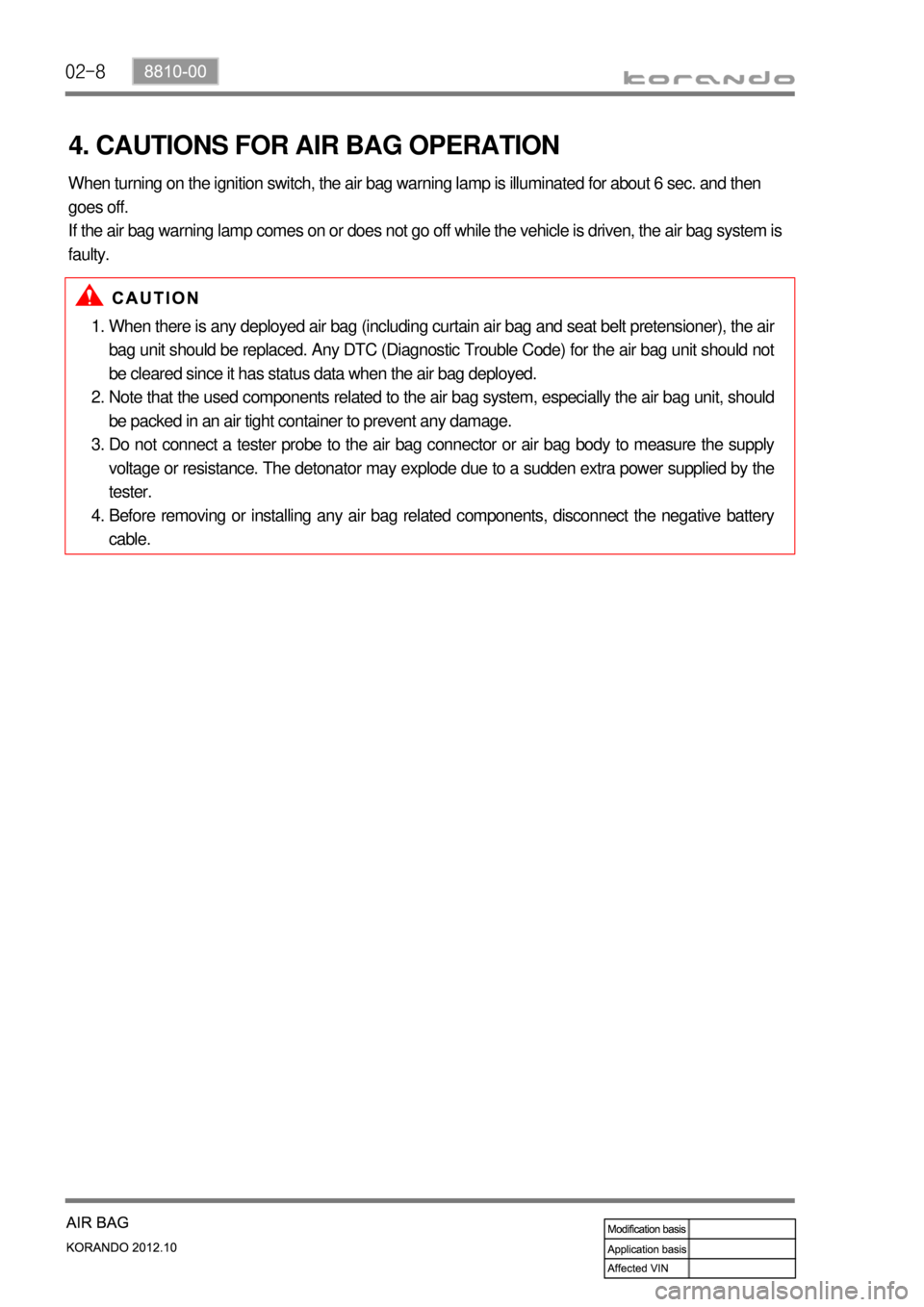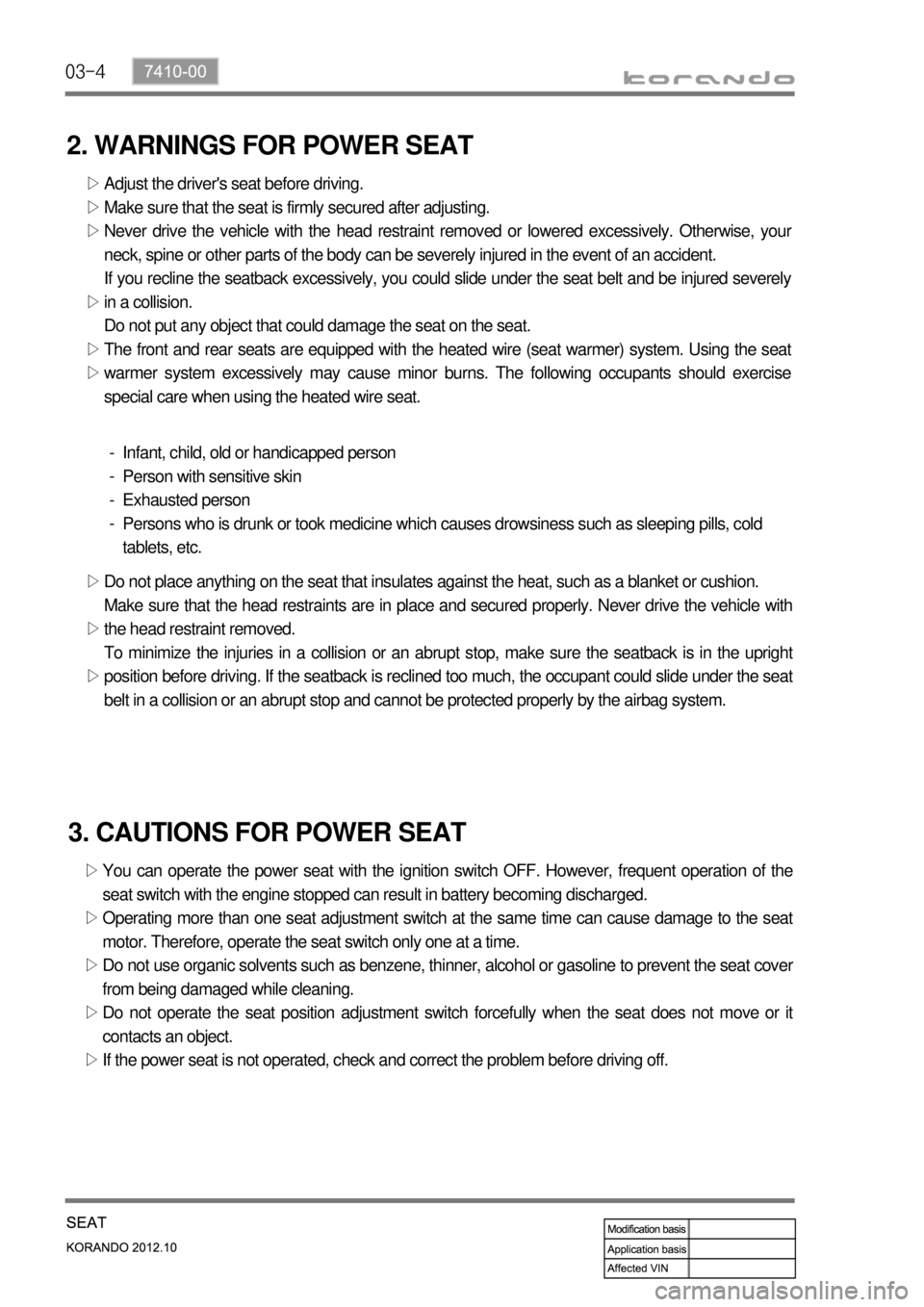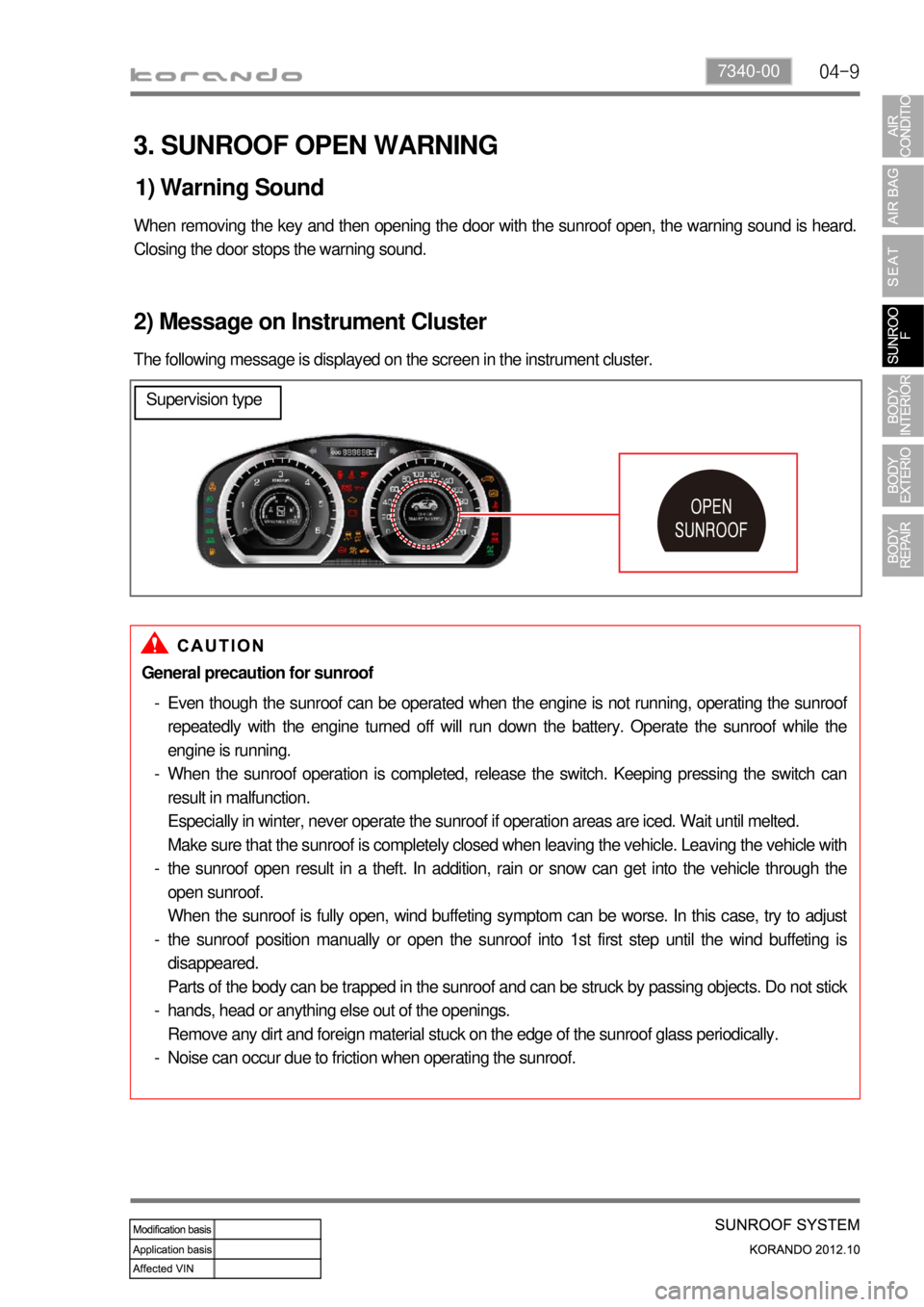Page 1022 of 1082

02-6
Seldom oeprate ▶The air bag deploys when: ▶
The air bag can deploy when: ▶a severe oblique collision occurs with a specific severity, angle, speed, and position. -
A collision with oblique impact to the front seat direction or a front collision to the diagonal
direction occurs.
a frontal or rear collision occurs.
The vehicle rolls over or tips over sideward with minor impact.
The air bag warning lamp is on. -
-
-
-the vehicle rolls over or tips over sideward with a severe impact.
The vehicle is stationary or a front collision occurs with low speed.
A rear collision occurs.
The impact of the collision is low enough for the seat belt to protect the occupant properly. -
-
-
-
Seldom oeprate ▶The air bag deploys when: ▶
The air bag can deploy when: ▶
The air bag does not deploy when: ▶
The vehicle is stationary or a front collision occurs with low speed.
A rear collision occurs.
The impact of the collision is low enough for the seat belt to protect the occupant properly. -
-
-
C. General Warnings for Air Bag
Do not check the circuits with a circuit tester. Do not attempt to modify any air bag component
including the steering wheel, air bag mountings and related wirings.
Do not subject any air bag component, such as the steering wheel, air bag mountings, wirings, to
impacts. You might get severely injured by sudden deployment of the air bag.
As the air bag/seat belt pretensioner parts are very hot after being deployed. Allow them to cool
down sufficiently before touching them.
The deployed air bag/seat belt pretensioner cannot deploy again. It will work when an additional
impact is applied. The components of the deployed air bag/seat belt pretensioner are non-reusable
parts. Therefore, remove or replace them as a unit.
The air bag and seat belt pretensioner systems contain explosive charges, so handle carefully when
disposing or replacing them.
Incorrect inspection can result in serious injuries or malfunctions in the air bag and seat belt
pretensioner system.
The air bag warning lamp is illuminated for 3 to 7 sec. after the engine is started to check the system.
Drive the vehicle after this warning lamp is turned off. If this warning lamp stays ON, the system may
be defective. Have the air bag system checked immediately by Ssangyong Dealer or Ssangyong
Authorized Service Center. -
-
-
-
-
-
-
Page 1024 of 1082

02-8
4. CAUTIONS FOR AIR BAG OPERATION
When there is any deployed air bag (including curtain air bag and seat belt pretensioner), the air
bag unit should be replaced. Any DTC (Diagnostic Trouble Code) for the air bag unit should not
be cleared since it has status data when the air bag deployed.
Note that the used components related to the air bag system, especially the air bag unit, should
be packed in an air tight container to prevent any damage.
Do not connect a tester probe to the air bag connector or air bag body to measure the supply
voltage or resistance. The detonator may explode due to a sudden extra power supplied by the
tester.
Before removing or installing any air bag related components, disconnect the negative battery
cable. 1.
2.
3.
4. When turning on the ignition switch, the air bag warning lamp is illuminated for about 6 sec. and then
goes off.
If the air bag warning lamp comes on or does not go off while the vehicle is driven, the air bag system is
faulty.
Page 1027 of 1082
02-118810-00
Inflatable curtain air bag module
Side air bag sensor
assembly
Front impact sensor
assembly
Air bag warning lamp
(IP)
Height adjuster
Page 1033 of 1082
02-178810-00
4. AIR BAG WARNING LAMP OPERATIONAL CONDITIONS
When there are no active and past faults ▶
The air bag warning lamp is operated as shown below if there is no fault occurred in the previous ignition
cycle and the SDM is running without any active fault right after starting the ignition cycle.
When there is no active fault and past faults occurred less than 10 times ▶
The warning lamp is operated as shown below every time the vehicle is started if the SDM is running
without any active fault in the entire time and past faults in the previous ignition cycle occurred within 10
times.
"Battery voltage too low" is not included in the past faults.
Page 1034 of 1082
02-18
When there is any active fault or past faults occurred 10 times or more ▶
If there is any active fault or past faults occurred 10 times or more in the last ignition cycle, the SDM
operates the warning lamp as shown below. If below conditions are met, the SDM is operated in the
same way.
Active fault
When the past faults occurred 10 times or more (except 'battery voltage too low')
Internal fault
Impact record
Pretensioner deployed only -
-
-
-
-
If the connector is not connected properly or SDM battery voltage is out of the specified range internally
(battery voltage for warning lamp), the warning lamp is kept ON.
Warning lamp condition change during operation ▶
The warning lamp comes on or off according to the actual fault condition during SDM operation. If there is
any active fault or active fault becomes past fault, the warning lamp is illuminated and if the fault is
deactivated, the warning lamp goes off.
Page 1037 of 1082

03-4
2. WARNINGS FOR POWER SEAT
Adjust the driver's seat before driving.
Make sure that the seat is firmly secured after adjusting.
Never drive the vehicle with the head restraint removed or lowered excessively. Otherwise, you
r
neck, spine or other parts of the body can be severely injured in the event of an accident.
If you recline the seatback excessively, you could slide under the seat belt and be injured severely
in a collision.
Do not put any object that could damage the seat on the seat.
The front and rear seats are equipped with the heated wire (seat warmer) system. Using the seat
warmer system excessively may cause minor burns. The following occupants should exercise
special care when using the heated wire seat. ▷
▷
▷
▷
▷
▷
Infant, child, old or handicapped person
Person with sensitive skin
Exhausted person
Persons who is drunk or took medicine which causes drowsiness such as sleeping pills, cold
tablets, etc. -
-
-
-
Do not place anything on the seat that insulates against the heat, such as a blanket or cushion.
Make sure that the head restraints are in place and secured properly. Never drive the vehicle with
the head restraint removed.
To minimize the injuries in a collision or an abrupt stop, make sure the seatback is in the upright
position before driving. If the seatback is reclined too much, the occupant could slide under the seat
belt in a collision or an abrupt stop and cannot be protected properly by the airbag system. ▷
▷
▷
3. CAUTIONS FOR POWER SEAT
You can operate the power seat with the ignition switch OFF. However, frequent operation of the
seat switch with the engine stopped can result in battery becoming discharged.
Operating more than one seat adjustment switch at the same time can cause damage to the seat
motor. Therefore, operate the seat switch only one at a time.
Do not use organic solvents such as benzene, thinner, alcohol or gasoline to prevent the seat cove
r
from being damaged while cleaning.
Do not operate the seat position adjustment switch forcefully when the seat does not move or it
contacts an object.
If the power seat is not operated, check and correct the problem before driving off. ▷
▷
▷
▷
▷
Page 1046 of 1082

04-97340-00
3. SUNROOF OPEN WARNING
1) Warning Sound
When removing the key and then opening the door with the sunroof open, the warning sound is heard.
Closing the door stops the warning sound.
2) Message on Instrument Cluster
The following message is displayed on the screen in the instrument cluster.
General precaution for sunroof
Even though the sunroof can be operated when the engine is not running, operating the sunroo
f
repeatedly with the engine turned off will run down the battery. Operate the sunroof while the
engine is running.
When the sunroof operation is completed, release the switch. Keeping pressing the switch can
result in malfunction.
Especially in winter, never operate the sunroof if operation areas are iced. Wait until melted.
Make sure that the sunroof is completely closed when leaving the vehicle. Leaving the vehicle with
the sunroof open result in a theft. In addition, rain or snow can get into the vehicle through the
open sunroof.
When the sunroof is fully open, wind buffeting symptom can be worse. In this case, try to adjust
the sunroof position manually or open the sunroof into 1st first step until the wind buffeting is
disappeared.
Parts of the body can be trapped in the sunroof and can be struck by passing objects. Do not stick
hands, head or anything else out of the openings.
Remove any dirt and foreign material stuck on the edge of the sunroof glass periodically.
Noise can occur due to friction when operating the sunroof. -
-
-
-
-
-
Supervision type